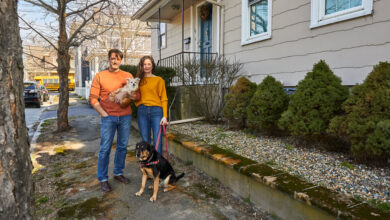Riverhead, N.Y.: A Long Island Community That’s Suddenly Popular

[ad_1]
Beth Anne Pike has been selling real estate in Riverhead, N.Y., for 20 years and cannot quite explain the town’s sudden popularity.
“Is it because farther east the prices have gotten out of control?” she asked about an exploding housing market that has made the North Fork of Long Island unaffordable for many of its longtime residents. “Or has it just become more desirable because of its location?”
Marking the end of the Long Island Expressway’s 71-mile stretch of banality, Riverhead is known for its farms, beaches, orchards, paddocks, golf courses, big-box stores, water park, raceway and vineyards. To many people, the town, which comprises the 15-square-mile census-designated place called Riverhead and several surrounding hamlets, is a signpost rather than a destination. Rolling off the highway into a shock of East End greenery, travelers start to count down the minutes to pastoral North Fork communities like Mattituck, Southold and Orient.
Lately, however, an influx of residents and visitors has jammed the roads east, and those minutes have piled up. What used to be a fluid half-hour drive from Riverhead to Greenport, 22 miles away, can now take more than an hour, depending on the month. (Autumn harvest season, which attracts pumpkin pickers, is the worst, locals say.) If the town once repelled some rural-home seekers with its gritty pockets and suburbanized spots, like Tanger Outlets, a shopping mall on West Main Street, it now shines with the advantage of proximity to the Hamptons, Nassau County and Manhattan. It is easy to get to, easy to leave.
At the same time, Riverhead is intent on giving people a reason to hang around. For a couple of decades, the town has been adding or repairing cultural touchstones on or near its historic Main Street, including the Long Island Aquarium; the 1881 Vail-Leavitt Music Hall; Tweed’s Restaurant and Buffalo Bar, in the Victorian-era John J. Sullivan Hotel building; and the Art Deco-style Suffolk Theater, which is undergoing expansion. Joining them will be a relocated Long Island Science Center with a rooftop planetarium.
As the pandemic has receded, new businesses have taken root or grown. Recent arrivals on Main Street include the Peconic County Brewing, the Privet consignment warehouse selling home goods from Hamptons estate sales, the Cuban restaurant Lucha Cubano, and the restaurant and catering company Insatiable Eats Creative Kitchen. This month, the East End Food Market, a winter farmers’ market on Main Road, northeast of downtown, announced plans to remain open year-round.
Rezoning for mixed-use development will continue to “bring life to the downtown that left when it no longer was our central business district,” said Dawn Thomas, the town’s community development director.
A project known as Town Square, spurred by an $800,000 state grant and soon to benefit from an additional $10 million in state funding, will open Main Street to the Peconic River and create retail and outdoor event spaces. (The area, which was inundated by Hurricane Sandy in 2012, is being developed with an eye to flood prevention, Ms. Thomas said.)
About 300 housing units, in a mix of affordable and market-rate, have been added or are in the process of being built downtown, and 200 market-rate units are on the boards. When Riverview Lofts, for example, was completed in 2020 on East Main Street, the 105 apartments (excluding 18 set aside for residents with physical disabilities) ranged from $1,095 for a below-market-rate studio to $2,500 for a market-rate two-bedroom. (No units are currently available.) Another 240 market-rate units are being planned for a transit-oriented district in the blighted area near the train station.
Expressing confidence that the existing infrastructure can support growth, Ms. Thomas said these new developments will help provide relief to the area’s workers, who have been priced out of the housing market.
But it’s not just laborers in this agricultural community who are struggling with affordability, she said. “The housing gap is in the single-family dwelling area. You can get an apartment, but not a house.” Her goal, she said, is “to help fill in those blanks.”
What You’ll Find
The county seat of Suffolk County, Riverhead stretches over 201 square miles of land and water, and contains all or part of the unincorporated hamlets of Baiting Hollow, Northville, Laurel, Jamesport, Aquebogue, Calverton, Manorville and Wading River.
The town has four public beaches — three on Long Island Sound — and several nature preserves, including a bog where cranberries were once harvested. Indian Island County Park, a 275-acre recreational spot at the mouth of the Peconic River, attracts hikers, campers, bird-watchers and fishers. Continuing a practice begun during the pandemic, the town is restricting parking at its beaches to residents. An annual permit is $20.
Riverhead is popular with retirees, who can choose among several communities for people 55 years and older. Last year, the Peconic Bay Medical Center, which is part of the Northwell Health system, unveiled a $67.8 million critical-care pavilion that doubled the size of the previous trauma facility.
In 2016, Susan and Robert Lorenz spent $440,000 for a 2,100-square-foot, two-story condo at Stoneleigh Woods, a 55-plus development two miles northwest of downtown and less than a mile from the medical center. The couple, who also have a home in Naples, Fla., paid a premium for a unit that backs onto a golf course, said Ms. Lorenz, 69, a retired vice president of sales at a home-furnishings company.
The condo’s annual property taxes of $4,500 are less than a third of what the Lorenzes paid in Huntington, N.Y., where they lived previously. But that’s also cheap for Riverhead, which despite robust commercial activity has the highest taxes on the North Fork. The couple has been spared, Ms. Lorenz believes, because a large proportion of property taxes goes to funding the school system, and Stoneleigh Woods does not permit residents under the age of 19. “It is truly for retirees,” she said.
Katherine Liepe-Levinson, 68, and her husband, Martin Levinson, 76, also came to Riverhead as part-timers. After living in an 1,100-square-foot manufactured home in a 55-plus enclave near the Long Island State Pine Barrens Preserve, they upsized in 2018 to a four-bedroom house at the Highlands Club, a homeowners’ association set on dozens of acres. During the pandemic they sold their primary home, in Forest Hills, Queens.
“If I stand here, I can see Briermere Farms,” said Ms. Liepe-Levinson, referring to a business on Sound Avenue that is celebrated for its fruit pies.
The 2009 house on almost half an acre at the Highlands Club had problems, but when Ms. Liepe-Levinson, a photographer, looked out the kitchen window and saw a barn, “That was it,” she said. The couple paid $520,000 and spent more on repairs. The property taxes are about $13,000.
A few miles north, in the Reeves Park neighborhood in Baiting Hollow, a beachfront community on Long Island Sound, Jennifer Sigelakis Agneta has been living full-time since 2017 in a 545-square-foot cottage bought originally for weekends. In 2015, the cottage cost $195,000. “Now, I don’t think you could buy into this neighborhood for less than $400,000,” she said.
Ms. Sigelakis Agneta, who is 57 and works in real estate marketing, said she respects why many longtime residents miss the North Fork’s sleepy ways. But having lived in downtown Salisbury, Md., she said she knows what a financially depressed community with low property values looks like. She is prepared to cheer on the pumpkin pickers.
“Yeah, there’s more traffic and people who don’t know how to drive in traffic circles,” she said. But the influx “also helps us to get more things in the area. Maybe we’ll get a movie theater one day.”
What You’ll Pay
In mid-March, a Zillow search showed 43 homes in the hamlet of Riverhead listed by agents. Among them were several manufactured houses in communities for families or people 55 years and older; asking prices began at $50,000 (for the structure alone), with a monthly lot rental fee of $723 that included taxes. Moving up in price, a four-bedroom, wood-shingled house built in 1930 near Main Street was listed for $599,990, with annual taxes of $7,849. Six years ago, the same property sold for $250,000.
Another four-bedroom, wood-sided house built in 1930, with Long Island Sound views and deeded beach access, was listed for just under $1.4 million, with annual taxes of $16,385. In 2008, the house sold for $430,000.
According to Redfin, the median sale price in the hamlet of Riverhead in February was $550,000, based on seven transactions, a year-over-year increase of 50 percent.
The Vibe
Riverhead, at the crux of the bifurcated East End, points to more than just geographical diversity. The town’s population of nearly 36,000 identifies itself as 15.3 percent Hispanic, 9.9 percent Black, 2 percent Asian and 1 percent multiracial, according to 2020 census data. Farmhouses, suburban ranch houses and 21st-century colonials sprouting from fields mix with beach cottages, gaudy Victorians and large, boxy structures looking homesick for an office park.
“I never thought I would be talking about tractors and, at the same time, go food shopping at Stop & Shop,” said Stephanie Pincar-Coleman, 37, who is originally from Staten Island and lives with her husband and two young children in Aquebogue. “And if we need eggs, we walk down to the farm.”
On Middle Road, which connects to Main Street in Riverhead, “you can literally pass a buffalo farm and sod farms,” she said. “You can see cows on the side of the road.”
The Schools
The Riverhead Central School District, which serves about 5,400 students from Riverhead, Southampton and Brookhaven townships, comprises four kindergarten-to-fourth-grade elementary schools, one fifth-to-sixth-grade elementary school, one seventh-to-eighth-grade middle school and one high school.
Riverhead High School enrolls about 1,900 students; 53 percent define themselves as Hispanic or Latino, 35 percent as white, 10 percent as Black, 1 percent as Asian or Pacific Islander and 1 percent as multiracial. The 2021 graduation rate was 82 percent. A quarter of the senior class passed at least one Advanced Placement test last year.
A $32.5 million program to expand and renovate the high school building and improve the campus it shares with Riverhead Middle School and Phillips Avenue Elementary School was completed in 2015.
The Commute
Riverhead is 90 minutes by car from Manhattan (in light traffic). Long Island Rail Road offers service to Pennsylvania Station two or three times a day. A weekday train departing at 6:03 a.m., with transfers in Ronkonkoma, N.Y., and Jamaica in Queens, arrives in Manhattan at 7:59 a.m. The fare is $30.50 peak and $22.25 off-peak, or $450 a month.
Buses on Hampton Jitney’s North Fork line depart Riverhead for various points in Manhattan Monday through Friday at 5:15 a.m., and daily at 8:40 a.m., with additional service throughout the day and on weekends. The trip is about two hours, and the fare is $29 prepaid or $36 on board; a book of 12 tickets is $289.
The History
Named for its position on the Peconic River, which was once occupied in part by the Corchaug people, Riverhead was carved out of the town of Southold in 1792 to make administration more manageable. (The territory was considered too big for residents to comfortably attend town meetings.)
The 15-block Polish Town enclave in the hamlet of Riverhead was settled by Polish immigrants fleeing the chaos of Eastern Europe in the early 20th century. Their influence is notable in street names like Pulaski and in an annual festival begun in 1974 that features traditional foods, costumes, crafts and polka music.
For weekly email updates on residential real estate news, sign up here. Follow us on Twitter: @nytrealestate.
[ad_2]
Source link





